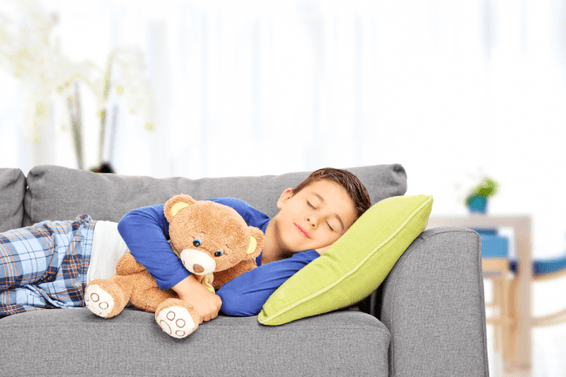
There are many factors that contribute to how fast you fall asleep and how well your sleep is once you are asleep. These factors include relaxation, quiet and darkness. One dynamic that is getting increasingly more attention among sleep experts, though, is temperature. Most people have experienced a night where sweltering heat made it difficult to doze off and caused them to toss and turn. But even minor deviations from your optimal sleep temperature can cause disruptions. The challenge here is that what is ideal varies from person to person, and you have to figure out your optimal temperature for yourself.
Your Optimal Sleeping Temperature
What is your ideal sleeping temperature? There is no one-size-fits-all answer. Finding out is going to be a process of trial and error, but there is a starting point available based on the average person. The sweet spot for most people is believed to be between 68 and 72-degrees Fahrenheit. Significant disruptions tend to occur below 65 and above 75 degrees. However, it is not unusual for the ideal temperature to be as low as 60 degrees. It is also worth noting that the range is a bit different among seniors. If you are 60 years or older, then you may want to start at between 66 and 70 degrees.
Foster a Bedtime Ritual That Prepares You to Be Comfortable
Comfort is as much a state of mind as a physical state of being. Sleep experts recommend developing a pre-sleep ritual that prepares you to sleep well. The perfect ritual varies from person to person, but there are some consistencies among most people. Quiet and darkness are important, and you should consider sleep aids in that area if you are particularly sensitive. Avoid caffeine and other stimulants six hours prior to bedtime. Emphasize your bedroom as a place to sleep. Watching TV in bed or staring at a tablet screen prior to dozing off can cause a lot of disruptions.
Keep a Log While Finding Your Ideal Sleep Temperature
Maintain a journal. Record your temperature and other settings for each night, and take notes about how easily you fell asleep, whether you noticed disruptions throughout the night and how you felt upon waking up. This information will prove invaluable over time, and sleep experts advise that such a journal can reduce this entire process to just several months rather than a year or more.
Assess How You Like to Sleep and Perhaps Try Some Changes
Take some time to consider how you feel most comfortable at night. Some people prefer to have little to no clothing and use a heavier blanket when it’s cold. Others prefer to wear pajamas and to use a lighter blanket or none at all. There really is no wrong or right answer here. It just matters what makes you feel more comfortable. If you’re not sure what your preferences are, spend a week or so using the average sweet spot temperature and try out different sleeping habits to see what works best for you.
Reach Your Optimal Temperature Before You Lie Down
A common mistake people make is having their settings established for exactly bedtime. But that guarantees that there will be a period of just lying there where your sleep temperature is not ideal. That can set off a chain reaction of disruptions. A better approach is to set your settings — temperature, humidity, bed temperature and so forth — to begin 30 minutes prior to when you lay your head down.
Setting the Room Temperature
As mentioned earlier, the sweet spot for most people is between 68 and 72-degrees Fahrenheit. But that temperature is going to be relative to your preferences and the choices you make. If you tend to run a little hot and like to wear a t-shirt and jogging pants to bed, 65 degrees is likely a better starting point for you. Also, if you do not already have one, invest in a smart thermostat that can adjust the temperature as needed 30 minutes prior to your normal bedtime.
Maintain Optimal Humidity as Well
Relative humidity is a factor as well because it determines how a temperature feels. A temperature will feel warmer at a higher relative humidity and cooler at a lower level. If high humidity in summer or low humidity in winter is a problem in your home, then you may want to consider a whole-home dehumidifier or humidifier, respectively. But when it comes to your bedroom, it’s simpler and more affordable to have a portable unit that helps lower or raise the humidity to your ideal level.
Consider a Smart Climate-Controlled Mattress
A climate-controlled mattress — or even a mattress pad — can be an excellent way to maintain your ideal body temperature. They can also help to control humidity and may even eliminate the need for a dehumidifier and humidifier. If you consider the investment, experts highly recommend a smart mattress or pad. This means that it’s not fixed to a particular setting but can rather adjust itself based on the ambient temperature and other factors.
Ensure That Your Bedroom Has Optimal Airflow
Airflow is important to being comfortable as well. Proper airflow adjusted for the season also results in you not having to set the temperature as low or as high. Many bedrooms have ceiling fans that are good enough to do the trick. If you prefer not to have a fan over the bed, you may want to consider an air circulator. An air circulator may sound like a fancy name for a fan, and it is, but a good air circulator can create an effective airflow pattern throughout a room that is comfortable but not intense.
Evaluate How You Feel in the Morning
Something you need to consider is that your temperature begins to drop once you have fallen asleep and continues to drop slowly throughout the night. This is where a smart climate-controlled mattress can make a big difference. If you wake up feeling colder than you would like, then you may have to set your starting temperature just a bit higher. If you wake up with cold feet that you know is not from a medical issue, then you may want to consider a heating pad or a zoned climate-controlled mattress.
Update Your Bedding Based on the Season
The final bit of advice is that your bedding should reflect the season. In spring and summer, you should opt for breathable bedding that maximizes airflow. As you progress into autumn, transition to bedding that’s less breathable and will help contain the warmth within your space.
Your Home Comfort Experts in San Antonio
Beyer Air Conditioning & Heating specializes in home comfort and provides a wide range of services throughout San Antonio and the neighboring communities. Our team installs, maintains and repairs all manner of residential heating and cooling systems. We offer maintenance programs that can help you save while keeping your HVAC equipment in tip-top shape. Our company also specializes in indoor air quality, and that includes air duct cleaning, air purifiers, humidifiers, dehumidifiers, ventilators and UV lights. Contact us online or call today to learn more about these services and to schedule an appointment!



